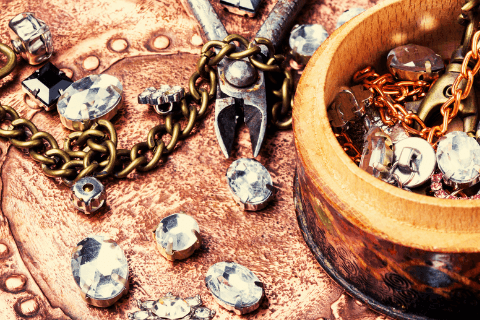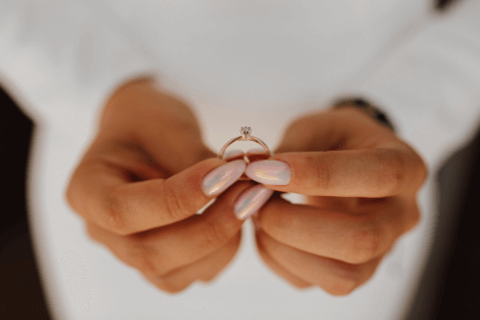The history of lab-grown diamonds
The fact that a diamond is a solid form of pure carbon molecule C with its atoms arranged in a crystal carbon, evolving with the help of extremely high pressure and temperature, only became known to humanity in the late 18th century. Ever since, researchers, independent chemists, and commissioned scientists have been looking to replicate the same process in the laboratory. Many authorities and individuals claimed they did it, but the very first reported lab-grown diamond was invented by Tracy Hall, a General Electric chemist, back in 1954.
In the beginning, lab grown diamonds were first limited to industrial use, so efforts at optimizing quality and increasing size options continued over time. In the 1970s, the firsts high gem-quality diamonds were successfully produced, and it’s only in the 1980s where lab-grown diamonds became more available to different industries. Still, it is only during the last decade that man-made diamonds have reached the highest quality standards to be eligible for fine jewelry creations, including fabulous diamond Engagement Rings. The industry of created diamonds and gemstones is still in continuous development to makes this precious gemstone more sustainable, ethical and accessible to the broader audience of diamond lovers!
What are lab-grown diamonds?
Also called man-made, engineered, or cultured diamonds, lab-grown diamonds are real diamonds formed in a different environment. They have the exact same chemical composition and physical properties of a natural diamond, which makes them practically indistinguishable from mined diamonds of equivalent quality.
Instead of forming over billions of years in the earth’s mantle, Etika Jewels®’ diamonds are sustainably grown above ground in labs with the help of the latest technology that replicates the natural diamond growing process. Lab-grown diamonds are developed in a much shorter growth cycle (around 2 months) than their mined counterparts formed over thousands of years. As diamond specialists, at Etika Jewels®, we only offer the finest lab-created colorless and fancy colored diamonds for all our gorgeous pieces.
Are lab-grown diamonds the same as simulants?
Lab-grown diamonds are not to be confused with imitations or simulants. Chemically, diamond simulants (like cubic zirconia or synthetic moissanite) are not diamonds at all. Natural and lab-created diamonds have the same high thermal conductivity that separates them from cubic zirconia, while their distinctive refractive properties set them apart from Moissanites. Any gemologist can easily differentiate between them with the naked eye. On the other hand, lab-grown diamonds are very challenging to detect since they have the same chemical and physical properties as mined diamonds.How are lab-grown diamonds graded?
Laboratory-grown diamonds undergo the same rigorous grading process as traditional diamonds. Just like traditional diamonds, lab-created diamonds are graded by assessing the four C’s of diamond quality: Cut, Color, Carat, and Clarity. Our lab-created diamonds come in classic cuts such as round, emerald, pear, cushion, princess, heart, oval, and marquis. All our lab-created diamonds are graded with a “very good” or “ideal” cut grade for maximum brilliance, and are colorless (D-E-F) or near-colorless (G-H). Etika Jewels®’ diamonds are always VVS1-VS2 in clarity, giving you a stone that you can be proud of on every level.
As a measure of our quality, all diamonds 0.50 carat and above come independently certificated by the International Gemological Institute (IGI). We understand that a diamond is a big investment, so we want you to rest easy knowing that your money is being well-spent — not only because of the joy it will bring but also because of the guarantee that it will last for a lifetime.
Are lab-grown diamonds more sustainable?
Sustainability is guaranteed with man-created diamonds. It’s all in the production methods. For earth-mined diamonds to be extracted, people dig miles and miles down, removing on average 250 tons of soil per carat of diamonds. These practices require more than 100 gallons of water per carat being extracted. The results of these operations are, most of the time, deforestation, soil degeneration, and large quantities of polluted wastewater. It’s challenging to the environment and the natural balance. Contrary to a diamond mined with heavy-duty equipment and explosives, the lab-grown diamond is one with a smaller impact on the earth’s resources. Its carbon emissions come down to only 4.8% of its mined counterpart, and overall emissions are a-billion-and-a-half times lower. Water and energy consumption are also 85% and 50% lower for those gems “born” in the laboratory. Per carat, they disrupt just 0.07 square feet of land, so numbers speak by themselves about how eco-friendly a lab-grown diamond is.How are lab-grown diamonds being made?
Lab-grown diamonds are made in laboratories using either the High-Temperature and High-Pressure method or the technique known as Chemical Vapor Deposition.
The first ever created method of forming diamonds in laboratories is High Pressure High Temperature or HTHP. The HPHT method involves placing a diamond seed within a chamber with graphite under high temperature and pressure to form a diamond rough, mimicking how diamonds are naturally made under the earth.
The more modern process: CVD, or Chemical Vapour Deposition, involves exposing a diamond seed to ionized hydrocarbon gases, allowing this way the carbon to be deposited on the seed, forming the diamond rough.
These two methods are still used today to grow man-made diamonds in laboratories; each method has its own practical purpose and should not be regarded as better or worse. For example, lab-grown diamonds under 1 carat weight are most of the time grown via HPHT, as it is the most cost-effective method. To the naked eye, both HTHP and CVD diamonds are certainly not discernible from each other, nor from natural diamonds.
The two methods can create diamonds of color and clarity grades across the spectrum, including Type IIa the most chemically pure of all diamonds. At Etika Jewels®, we only offer the superior type IIa diamonds, the purest form of diamond known to man. Type IIa diamonds are free from nitrogen or boron impurities, making them the most chemically pure of all diamonds. Lab-grown type lla diamonds are becoming a popular choice with buyers because of their sheer brilliance and sense of perfection that lasts a lifetime.
Are lab-grown diamonds conflict-free and ethical?
Celebrities have for many years denounced the idea of wearing the so-called “blood diamonds” on the red carpet. Global authorities (like the United Nations or World Diamond Council), who came up with a set of regulations in the Kimberley Process, call these stones “conflict diamonds” because they have funded conflict and war in many countries, including Sierra Leone, Liberia, or Angola.
Semi-precious gemstones have also financially supported military regimes threatening to eliminate minorities such as the Rohingya in Myanmar. Although 70 countries pledged in 2003 to trace all mined diamonds and certify only the conflict-free ones, controls need to be optimized further to eradicate illegal trade and all the cruelty and injustices that come with it.
Work conditions are not always fair and safe, and many human rights violations are still ongoing. Adults are still recruited under unfavorable and dangerous conditions, and child labor, sometimes for ages as young as four years old, is still an issue in diamond mining in many countries. Even with certified mined diamonds, and although the authorities try their best to ensure transparency, it is hard to check the overall supply chain thoroughly. A mined gemstone has to be transported to different locations across the globe to be cut, polished, graded, and processed generally. It’s a long trip, and it is easy to lose the trail of its origins and hard to evaluate the ethics in each step of the process.
At Etika Jewels® we are bringing an ethical diamond alternative to mined ones. Undeniably, a lab-grown diamond is far more traceable and guaranteed to be fair, ethical, and cruelty-free.
Are lab-grown diamonds less expensive?
Indeed, the price of a lab-grown equivalent to a mined diamond is 20% to 40% lower, an attractive reality for the luxury shopper, which does not reflect lower quality or smaller inherent value but a shorter supply chain. The longer supply chain of mined diamonds involves high transportation costs with as many as 20 stops across different continents. These gems change many hands until they reach their point of sale. Each of the middlemen of the supply chain put their own markup, resulting in a higher retail price unrelated to the quality and resale value of the gemstone.
In other words, you can get a bigger and better stone for the same money with lab-grown diamonds, which can also be regarded as an heirloom with an ethical legacy. The value of the lab-grown diamonds reflects all the science, research and ingenuity invested in their making. They are eco-friendly miracles of science that the current and next generations are proud of. You get a real diamond at a better value of money. And to be even more practical, most man-made diamonds in the market are of higher quality than 97% of the mined ones. Their majority is meticulously engineered to be top-quality, which means the perfect choice for special-occasion jewelry!
Will lab-grown diamonds last forever?
What determines a gemstone’s durability and scratch resistance is its ranking on the Moh’s Scale, which for a diamond is 10. This number shows that a diamond is the hardest and most durable mineral. Mined and lab-grown diamonds are chemically, physically and optically identical because they share the same molecular structure, which accounts for very strong materials that last forever. They are hard to scratch or fracture and maintain their impeccable surface and mesmerizing brilliance for generations. Whether a diamond grows in the earth’s depths or inside a latest-technology laboratory doesn’t matter, it is evaluated as equally resilient and lasting, a timeless beauty in your jewellery box. What makes the value of a man-created diamond even more enduring and significant is its ethical aspect, leaving behind a heritage of responsible luxury. Lab-grown diamonds stand the test of time, opening a new chapter for humanity dedicated to sustainability, inclusivity, compassion, and fair trade practices. “Diamonds are forever” when representing timeless values with a positive impact on us all!
Are lab-grown diamonds a good investment?
For half a century, diamond jewelers and retailers have been selling mined diamonds, convincing their clients that they will have a higher resale value. In fact, except for very rare, high-weight and high-quality mined diamonds, most of the purchased diamonds cannot be resold at the same or higher price. On the contrary, the moment we buy it, we lose of its retail value. This happen because we pay for all the markups of the supply chain on the stone, while a similar stone is easily available directly from the wholesalers for less money. The belief that diamonds are rare is a myth, mined diamonds are actually of the least rare among all gemstones, as per the International Gem Society.
What’s a diamond’s value, then? It comes down to the actual legacy it leaves as a precious and unique object. A lab-grown diamond is the new standard for responsible luxury. You can pass it down to your loved ones, making them proud of an ethical and sustainable approach. It represents the triumph of a generation that respects the environment and cares for the future of humanity. By buying lab-grown diamonds, you invest in an industry that makes the world a better place.




